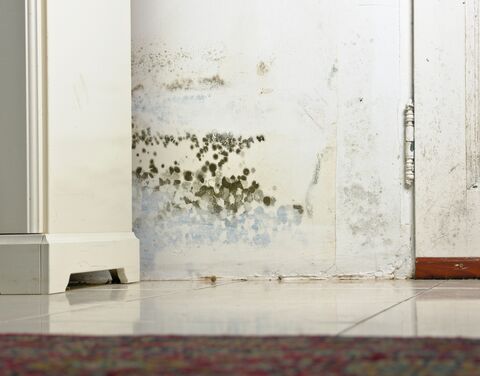
Mold in your apartment – what can you do and who should pay for it?
Ugh, there’s mold growing on my walls! This gray pest is not only irritating, it also damages your home and, worst of all, is harmful to your health. And as if that weren’t enough, it could also lead to legal disputes and get you dragged into financial discussions with your landlady/lord. We will shed some light on the legal aspects, clarify your insurance situation and give you some pointers on how to avoid mold in your apartment.
Having mold growing in your apartment is not only annoying and dangerous, it often leads to squabbles between you and your landlady/lord. Because calling in experts just to assess the situation can cost several thousand francs. Whoever is responsible for the mold is the one who will have to pay to remove it.
And the result of this is often protracted discussions and accusations by both parties – definitely not something you need when you’re already dealing with a trying situation.
Mold on the wall: why this happens
Leaky roofs, undetected ruptured pipes in walls or the build-up of condensation due to faulty thermal bridges: Mold can have many causes. It can pop up quicker than you think. Every fourth or fifth household has problems with dampness.
Unfortunately for us, mold is very undemanding when it comes to growing conditions. It takes very little for it to flourish and it loves humidity in walls. The perfect breeding ground for mold is when the air in a room remains humid over a longer period of time.
What is surprising is that mold affects not only older apartment buildings, but many newly renovated or even newly constructed buildings as well. The reason for this is because they are engineered to be increasingly airtight, which makes natural air circulation more difficult. The result is higher humidity in rooms and walls, which provide the ideal growing conditions for mold and mildew. At home, you can help keep mold at bay by airing out and heating rooms properly. This way you’ll never have to deal with an infestation.
Mold damage due to faulty construction – who is liable for what?
If the mold infestation in a building was clearly caused by faulty construction, then the landlady/lord must pay for the damages. As a tenant, you have the right to a reduction in your rent for the time during which you cannot use the apartment as set out in your rental contract. The amount of the reduction depends on the extent to which you are not able to use the apartment.
If, however, there is evidence that you as the tenant caused the mold in the building, then the costs for removing the mold may be passed on to you. Your personal legal protection insurance does not cover this type of situation because the damage is due to the gradual effects of factors such as temperature, atmospheric conditions and humidity. If you have personal legal protection insurance, then check to see whether your policy includes legal advice.
Various shades of gray: the legal situation as regards mold in your apartment
Notify your landlady/lord as soon as you discover mold in your apartment. Ideally, you should do this in writing. And it’s important to take photographs to document the mold – including its progression. Initially, your landlady/lord may be very uncooperative or disinclined to seek a joint solution to this problem. Where mold is concerned, there can be a lot of finger pointing and bad feelings. The result is interminable discussions about tenancy law that can quickly escalate into legal battles.
If you have a mold infestation, request that your landlady/lord bring in an expert to provide an assessment or a report. Refuse to accept any blame until the causes have been definitively identified and the expert report is available.
How you’re covered for mold infestations:
Our bonus tip: Save for your retirement with rental guarantee insurance
If the expert concludes that you are responsible for the mold infestation, then in the worst case, you will be stuck paying for the removal of the mold.
But things are different if you have rental guarantee insurance, because then the insurer will pay for it and you will only have to pay them back later on. The insurer will also check to see whether you really need to pay for the mold removal or whether your personal liability insurance will cover it.
Mold in your apartment puts your health at risk
Poor air quality and a foul smell are the first signs of mold in your home. Often you won’t see any of the typical gray spots on the wall. Infestations are sometimes not visible at all and can hide in your walls or behind furniture that has been pushed up close to the wall. The invisible spores will nonetheless spread through the room and over time throughout your entire apartment or house. A small concentration of mold poses no risk to your health. But once the concentration reaches a certain density, it puts a strain on your respiratory tract and is bad for your health in general. Mold in the bedroom in particular can be injurious over a longer period of time because this is generally where we spend most of our time.
Typical symptoms triggered by mold in your apartment:
- Sleep disturbances and concentration disorders
- Inflammation of the mucous membranes
- Difficulty seeing and breathing
- Scratchy throat
- Burning eyes
- Tiredness
And sometimes headaches, joint pain and digestive disorders can also develop. Particularly annoying is the fact that it is not easy to establish a direct correlation between these symptoms and a mold infestation, much less prove it.
Preventing mold: Our tips
It’s well know that prevention is better than cure. But if you already have a large infestation, the experts advise you to remove it as soon as possible. In areas where there is a smaller amount of mold, it’s best if you wash the moldy spots with a five-percent caustic soda solution and 80-proof alcohol. Make sure to protect your eyes and skin while you remove the mold from the wall. If the mold is widespread, you may have to replace the carpet, resurface the walls or even reinstall faulty insulation. You will need to call in the professionals for this.
We have compiled a list of five tips so that it won’t come to this in the first place.
Tip 1: Air out your rooms. Again and again and again
Especially after you shower, bathe or cook. But even watering plants or running the dryer can raise the humidity. Doing yoga or working out at home can also cause the moisture level in your home to rise. Thoroughly airing out the room on a regular basis is the key to preventing mold in your apartment.
Ideally, you should air out your rooms three to five times a day, even if it’s cold or rainy out. Make sure that the air in the room is completely replaced by outside air at least once. This should take between five and ten minutes each time. Do not leave the windows cracked open for a long time because this does not air the room out completely. What it does is cool down the walls, which makes them more prone to condensation.
Tip 2: Heat your rooms the right way
Cold rooms are more conducive to mold than heated rooms. So make sure that your rooms are at least 16 degrees Celsius. The ideal temperature is between 19 and 20 degrees. Air that is too warm absorbs water vapor, which can also cause mold to grow. Even in winter you should never heat your rooms to over 20 degrees. Mold can quickly start to grow in the shower or bathroom, so you need to pay close attention to the temperature in there.
Tip 3: Use caution if there is a big difference in the temperature of your rooms
Try to ensure that there is no more than five degrees difference in temperature between any of your rooms. And always keep the doors to cooler rooms closed because the humidity quickly causes condensation to form on the walls, providing the ideal growing conditions for mold and mildew.
Tip 4: The right level of humidity
In addition to fresher and warmer air, you also need to pay attention to the level of humidity. This is a problem particularly in new buildings because there is still a lot of humidity left in the walls or attic as a result of construction. If you want to be really safe, you can use a thermo-hygrometer to find out the exact level of humidity. Somewhere in the range between 40 and 60 percent humidity is ideal to prevent mold from growing in your apartment and to speed up the drying process.
Tip 5: Reach out to a specialist
Bring in the professionals. Many types of mold damage can only be removed and remedied by a professional. Oftentimes the damage is detected rather late, which makes it difficult to clean it up thoroughly. There are bound to be some mold experts available in your region. Get in touch with them. If the mold isn’t very widespread, then you can use simple household cleaners such as vinegar or alcohol solutions to clean it.








